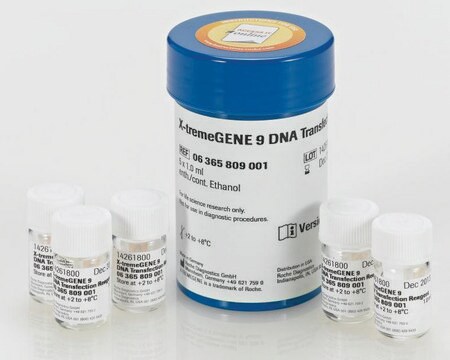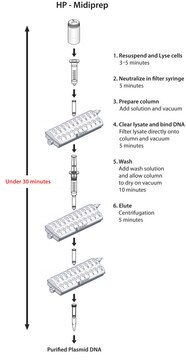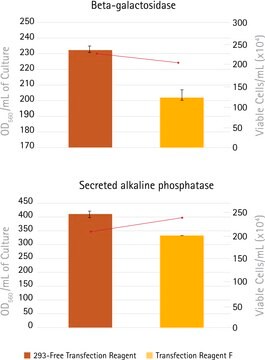T0956
Sigma Universal Transfection Reagent
Polymer reagent for transfecting common mammalian cell lines
About This Item
Prodotti consigliati
Grado
for molecular biology
Livello qualitativo
Sterilità
aseptically filled
Forma fisica
liquid (buffered aqueous solution)
impiego
sufficient for 110 transfections (3.5 cm dish)
sufficient for 40 transfections (10 cm dish)
sufficient for 65 transfections (6 cm dish)
Concentrazione
2 mg/mL
Temperatura di conservazione
−20°C
Descrizione generale
Applicazioni
Excellent for:
BHK-21
CHO
CHOK1
HEK293
HeLa
NIH3T3
Good for:
3LL
6CSFME
ATT20B16-F0
B16-F10
BAEC
Ca Ski
COS-7
CV-1
D 407
HUVEC
L929
MCF-7
MDCK
Neuro2A
SAOS-2
SHEP
SiHa
SKOV3
Caratteristiche e vantaggi
- Fast, easy protocol
- Suitable for stable and transient transfection
- High efficiency for a wide variety of cell types including primary cells
- Compatible with both serum and serum-free transfection protocols
Componenti
Principio
Altre note
Prodotti correlati
Codice della classe di stoccaggio
12 - Non Combustible Liquids
Classe di pericolosità dell'acqua (WGK)
WGK 1
Punto d’infiammabilità (°F)
Not applicable
Punto d’infiammabilità (°C)
Not applicable
Certificati d'analisi (COA)
Cerca il Certificati d'analisi (COA) digitando il numero di lotto/batch corrispondente. I numeri di lotto o di batch sono stampati sull'etichetta dei prodotti dopo la parola ‘Lotto’ o ‘Batch’.
Possiedi già questo prodotto?
I documenti relativi ai prodotti acquistati recentemente sono disponibili nell’Archivio dei documenti.
I clienti hanno visto anche
Il team dei nostri ricercatori vanta grande esperienza in tutte le aree della ricerca quali Life Science, scienza dei materiali, sintesi chimica, cromatografia, discipline analitiche, ecc..
Contatta l'Assistenza Tecnica.















